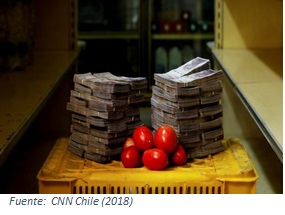Venezuelan inflation. Nominal and real quarterly variations of Venezuela in the 2005-2017 period
DOI:
https://doi.org/10.17981/econcuc.41.1.2020.Econ.6Keywords:
Artificial credit expansion, Inflation, Monetary liquidity, Monetary base, Financial indexesAbstract
This research studied Venezuelan credit and inflation during the 2005-2017 period. For this, it was presented with the objective of identifying the nominal and real quarterly variations in Venezuela in the 2005-2017 period. Methodologically it was based on quantitative research, this being a correlational study in which the data were taken from the statistical information reports provided by the Central Bank of Venezuela (2017) and SUDEBAN (2017). The results allowed us to observe the behavior of the nominal and real quarterly variations of Venezuela, allowing to consider the great relevance of the inflationary processes in the dynamics of the nations, both locally and internationally; highlighting how in the financial indexes of the Venezuelan nation in the official data there is a contradiction with the current reality.
Downloads
References
Anderson, D., Sweeney, D. y Willians, T. (2008). Métodos cuantitativos para los negocios. (9 ed.). México, D.F.: Thomson.
Azuero, S. (1990). Contratos bancarios. Su significación en América Latina. Bogotá, D.C.: Biblioteca Felaban (Federación Latinoamericana de Bancos).
Baptista, A. (2011). Bases cuantitativas de la economía venezolana. Caracas: Artesanogroup.
BCV. (2017). Boletín de Indicadores Semanales. Semana #49 2017. Caracas: BCV. Recuperado de http://www.bcv.org.ve/publicaciones/boletin-de-indicadores-semanales-semana-49-2017
Blanchard, O. (2005). Macroeconomía. México, D.F.: Pearson Prentice Hall.
Braun, E. (2013). A French Predecessor of the Austrian Theory of the Business Cycle- Marcel Labordère on the American Crisis of 1907. Journal of Prices & Markets, 1(1), 49–56.
Cantillón, R. (2002). Essay on the nature of Trade in General. Indianápolis: Liberty Fund, Inc.
Casas, J. (2017). Implicaciones de los acuerdos del Fondo Monetario Internacional sobre la pobreza en Colombia. Económicas CUC, 38(1), 9–36. http://dx.doi.org/10.17981/econcuc.38.1.01
Chiang, A. y Wainwright, K. (2006). Métodos fundamentales de economía matemática. (4 ed.). México, D.F.: McGraw-Hill.
De Soto, J. (2011). Dinero, crédito bancario y ciclos económicos. Madrid: Unión.
Friedman, M. y Meiselman, D. (1963). The Relative Stability of Monetary Velocity and the Investment Multiplier in the United States, 1898-1958. In: Commission on Money and Credit, Stabilization Policies (pp. 165–268). Englewood Cliff: Pretince Hall. Available from https://dspace.mit.edu/bitstream/handle/1721.1/48963/relativestabilit00ando.pdf?sequence=1&isAllowed=y
Friedman, M. (2005). The Optimum Quantity of Money. Piscataway: Aldine Transaction Publishers.
Gómez, R. (2008). La Teoría Del Ciclo Económico De Friedrich Von Hayek: Causas Monetarias, Efectos Reales. Cuadernos de Economía, 27(48), 47–69. Disponible en https://revistas.unal.edu.co/index.php/ceconomia/article/view/1451
Henríquez, G., Rada, J. y Torrenegra, A. (2016). Medición de variables psicológicas, económicas y sociales para identificar factores ocultos de los emprendedores en Barranquilla. Económicas CUC, 37(1), 177–202. https://doi.org/10.17981/econcuc.37.1.2016.08
Hernández, G. H. (2011). La gestión empresarial, un enfoque del siglo XX, desde las teorías administrativas científica, funcional, burocrática y de relaciones humanas. Escenarios, 9(1), 38–51. Disponible en http://hdl.handle.net/11619/1628
Hernández, R., Fernández, C. y Baptista, P. (2010). Metodología de la investigación. (5 ed.). México, D.F.: McGraw-Hill.
Herrera, A., Balbis, M., Gómez, A. y Hernández, H. (2015). Pragmatismo competitivo de las pymes de la Región Caribe. Barranquilla: CUL. Disponible en http://hdl.handle.net/11323/3188
Jevons, S. (1998). La Teoría de la economía Política. Madrid: Pirámide.
Lorente, L. (2019). Crecimiento, crédito e inflación. Revista de Economía institucional, 21(40), 9–68. https://doi.org/10.18601/01245996.v21n40.02
Mises, L. (1982). The Theory of Money and Credit. Indianapolis: Liberty Fund.
Palella, S. y Martins, F. (2012). Metodología de la investigación cuantitativa. (5 ed.). Caracas: FEDUPEL.
Paredes, J. (2017). Planificación financiera ante la perspectiva organizacional en empresas cementeras del estado ZuliaVenezuela. Económicas CUC, 38(1), 105– 132. http:// dx.doi.org/10.17981/econcuc.38.1.05
SUDEBAN. (2017). Información Estadística. [Online]. Disponible en http://www.sudeban.gob.ve/index.php/gide_informacion-estadistica/
Thornton, H. (2000). Crédito papel. Madrid: Pirámide.
Urdaneta, A. (2017). Mecanismos de transmisión de la política monetaria en la economía venezolana 1984-2013. Revista Innovación y Gerencia, 9(1), 69–95.
Urdaneta, A., Prieto, R. y Hernández, O. (2017). Formación bruta de capital fijo en el producto interno bruto venezolano en el período 1997-2015. Desarrollo Gerencial, 9(1), 52–80. https://doi.org/10.17081/dege.9.1.2725
Villar, L., Salamanca, D. y Murcia, A. (2005). Crédito, represión financiera y flujos de capitales en Colombia: 1974-2003. Revista Desarrollo y Sociedad, (55), 167–209. https://doi.org/10.13043/dys.55.4
Wicksell, K. (1962). Interest and Prices. A study of the causes regulating the value of money. New York: Kelley.
Zúñiga, J. (2017). De la función económica del cheque, del cheque común al de pago diferido. Jurídicas CUC, 13(1), 183–198. https://doi.org/10.17981/juridcuc.13.1.2017.08

Published
How to Cite
Issue
Section
License
Copyright (c) 2020 Remedios Pitre Redondo, Armando Urdaneta, Hugo Hernandez Palma

This work is licensed under a Creative Commons Attribution-NonCommercial-NoDerivatives 4.0 International License.
You are free to:
- Share — copy and redistribute the material in any medium or format
- The licensor cannot revoke these freedoms as long as you follow the license terms.
Under the following terms:
- Attribution — You must give appropriate credit , provide a link to the license, and indicate if changes were made . You may do so in any reasonable manner, but not in any way that suggests the licensor endorses you or your use.
- NonCommercial — You may not use the material for commercial purposes .
- NoDerivatives — If you remix, transform, or build upon the material, you may not distribute the modified material.
- No additional restrictions — You may not apply legal terms or technological measures that legally restrict others from doing anything the license permits.

 English
English
 Español (España)
Español (España)














